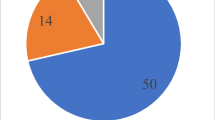Abstract
This study was undertaken to ascertain if the soft rot inciting Pectobacterium carotovorum/Erwinia carotovora would pass through the micropropagated bananas as a latent pathogen and cause disease during or post acclimatization. In vitro cultures of ‘Grand Naine’ were exposed to the pathogen by providing 100 μl of inoculum (0.001–1.0 at OD600 nm) at the lower leaf axil. These cultures showed a gradual development of soft rot symptoms coupled with obvious bacterial colony growth on banana proliferation medium and consequent plant mortality within a month irrespective of the inoculum level employed. Plants carried forward to acclimatization following inoculation in vitro failed to establish ex vitro. Monitoring the normal field-grown suckers at culture initiation through PCR screening employing soft rot Erwinia primers did not show the amplification of the 119-bp fragment as seen with the pure cultures of pathogen. Further testing of micropropagated banana plants through soil inoculation, in vitro culturing and PCR screening ruled out the possibility of the pathogen surviving in micropropagated stocks in latent form as the organism outgrew and killed the cultures. It emerged that the infection possibly takes place in the nursery. This information will be of particular value for the plant tissue culture industry, plant pathologists and quarantine agencies.






Similar content being viewed by others
Abbreviations
- BPM:
-
Banana proliferation medium
- NA:
-
Nutrient agar
- SRE primers:
-
soft rot Erwinia primers
References
Brenner DJ, Steigenvalt AG, Miklos GV, Fanning GR (1973) Deoxyribonucleic acid relatedness among erwiniae and other enterobacteria. I. The soft rot organisms (genus Pectobacterium Waldee). Int J Syst Bacteriol 23:205–216
Euze′by J (2003) Notification that new names and new combinations have appeared in volume 53, part 2, of the IJSEM. Int J Syst Evol Microbiol 53:939–940
Hankin L, Zucker AM, Sands DC (1971) Improved solid medium for the detection and enumeration of pectolytic bacteria. Appl Microbiol 22:205–209
Herman EB (1987) Contamination of plant tissue cultures: towards control of micropropagation contamination. Agricell Rep 9:33–34
Knauss JF, Miller JW (1978) A contaminant, Erwinia carotovora, affecting commercial plant tissue cultures. In Vitro Cell Dev Biol Plant 14:754–756
Kwon SW, Go SJ, Kang HW, Ryu JC, Jo JK (1997) Phylogenetic analysis of Erwinia species based on 16s rRNA gene sequences. Int J Syst Bacteriol 47:1061–1067
Leifert C (2000) Quality assurance systems for plant cell and tissue culture; the problem of latent persistence of bacterial pathogens and Agrobacterium-based transformation vector systems. Acta Hortic 530:87–92
Leifert C, Cassells AC (2001) Microbial hazards in plant tissue and cell cultures. In Vitro Cell Dev Biol Plant 37:133–138
Leifert C, Waites WM (1992) Bacterial growth in tissue culture media. J Appl Bacteriol 72:460–466
Murashige T, Skoog F (1962) A revised medium for rapid growth and bioassays with tobacco tissue cultures. Physiol Plant 15:473–497
Patil P, Singh HP (2000) In vitro multiplication of banana varieties belonging to different genome and ploidy levels. In: Singh HP, Chadha KL (eds) Banana improvement, production and utilization. Association for the Improvement in Production and Utilization of Banana, Trichy, pp 228–232
Pirttilä AM, Janne OP, Kosimäki J, Hohtola E, Hohtola A (2008) Role of origin and endophyte infection in browning of bud-derived tissue cultures of Scots pine (Pinus sylvestris L.). Plant Cell Tiss Org Cult 95:47–55
Ravindra MB, Thomas P (1995) Sachet technique—an efficient method for the acclimatization of micropropagated grapes (Vitis vinifera L.). Curr Sci 68:546–548
Roels S, Escalona M, Cejas I, Noceda C, Rodriguez R, Canal MJ, Sandoval J, Debergh P (2005) Optimization of plantain (Musa AAB) micropropagation by temporary immersion system. Plant Cell Tissue Org Cult 82:57–66
Selvarajan R (2009) Ensuring quality of micropropagated plants through virus indexing. In: 2nd Natl Conf Banana. Jalgaon, Maharashtra, India, pp 39–48
Singh HP (2009) Production of quality planting material in banana. In: 2nd Natl Conf Banana. Jalgaon, Maharashtra, India, pp 1–14
Thangavelu R (2009) Management of fungal and bacterial diseases in micropropagated plants. In: 2nd Natl Conf Banana. Jalgaon, Maharashtra, India, pp 101–107
Thomas P (2004a) In vitro decline in plant cultures: detection of a legion of covert bacteria as the cause for degeneration of long-term micropropagated triploid watermelon cultures. Plant Cell Tissue Org Cult 77:173–179
Thomas P (2004b) A three-step screening procedure for detection of covert and endophytic bacteria in plant tissue cultures. Curr Sci 87:67–72
Thomas P, Kumari S (2010) Inconspicuous endophytic bacteria mimicking latex exudates in shoot-tip cultures of papaya. Sci Hortic 124:469–474
Thomas P, Soly TA (2009) Endophytic bacteria associated with growing shoot tips of banana (Musa sp.) cv. Grand Naine and the affinity of endophytes to the host. Microb Ecol 58:952–964
Thomas P, Swarna GK, Patil P, Rawal RD (2008a) Ubiquitous presence of normally non-culturable endophytic bacteria in field shoot-tips of banana and their gradual activation to quiescent cultivable form in tissue cultures. Plant Cell Tiss Org Cult 93:39–54
Thomas P, Swarna GK, Roy PK, Prakash P (2008b) Identification of culturable and originally non-culturable endophytic bacteria isolated from shoot tip cultures of banana cv. Grand Naine. Plant Cell Tiss Org Cult 93:55–63
Toth IK, Hyman LJ, Wood JR (1999) A one step PCR-based method for the detection of economically important soft rot Erwinia species on micropropagated potato plants. J Appl Microbiol 87:158–166
Ulrich K, Stauber T, Ewald D (2008) Paenibacillus—a predominant endophytic bacterium colonising tissue cultures of woody plants. Plant Cell Tissue Org Cult 93:347–351
Acknowledgments
The technical help provided by N. Shivarudraiah and the laboratory support from Aparna, Reshmi and Mujawar are gratefully acknowledged. This publication is IIHR contribution No. 49/2010.
Author information
Authors and Affiliations
Corresponding author
Rights and permissions
About this article
Cite this article
Thomas, P., Goplakrishnan, C. & Krishnareddy, M. Soft rot inciting Pectobacterium carotovorum (syn. Erwinia carotovora) is unlikely to be transmitted as a latent pathogen in micropropagated banana. Plant Cell Tiss Organ Cult 105, 423–429 (2011). https://doi.org/10.1007/s11240-010-9882-6
Received:
Accepted:
Published:
Issue Date:
DOI: https://doi.org/10.1007/s11240-010-9882-6




